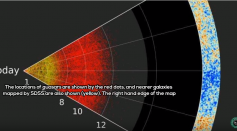dark matter

Largest Telescope Square Kilometre Array (SKA) Will Soon Open Its Eye on Universe, Potentially Answer Some Questions About Dark Matter

What’s Next for ESA’s Euclid Space Telescope After ‘Fantastic Launch’?

ESA Euclid Space Telescope With Infrared Detectors Will Look Into Dark Matter: Report

HighlY Interactive ParticlE Relics Experiment (HYPER) Model Proposed by Scientists to Explain Dark Matter Formation in Early Universe

$60 Million Project With Specialized Detector LUX-ZEPLIN (LZ) to Find Dark Matter Already Operating in South Dakota
Sagittarius A* Might Not Be a Black Hole After All, Hints Toward Dark Matter Mass
Optical Clocks Narrow Down the Search for Dark Matter

Dark Distortions: Art Installation Demonstrates How Dark Matter Interacts With Light

LIGO Detected Gravitational Waves That Intrigues The Nature Of Black Holes & Dark Matter For The Third Time

Astronomers Redesign PICO Bubble Chamber to Detect The Trace of Dark Matter in WIMPs

New Unit BAO Reveled By Astronomers To Measure The Distances Between Galaxies And Quasars

Evidence of Dark Matter Emits Gamma Rays Radiation Has Weakened with Latest Analysis

The Biggest Mystery Of The Entire Universe: What The Dark Matter Really Is

Hunting For Dark Matter: Physicist Establish An Underground Facility In An Abandoned Gold Mine
Most Popular

How Technology Is Changing the Real Estate Industry?

Study Reveals High Turnover in Scientific Research Careers: What This Means for Future Scientists

Nikolay Karpenko Biography, Photo, Career, Accomplishments

How a Plant-Based Diet Can Protect Against Breast Cancer: Insights from Nutrition Research






